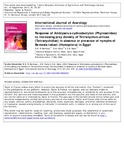| dc.contributor.author | El-Banhawy, EM | |
| dc.contributor.author | Hafez, SM | |
| dc.contributor.author | Saber, SA | |
| dc.date.accessioned | 2013-07-01T13:10:06Z | |
| dc.date.available | 2013-07-01T13:10:06Z | |
| dc.date.issued | 2001 | |
| dc.identifier.citation | International Journal of Acarology Volume 27, Issue 3, 2001 | en |
| dc.identifier.uri | http://www.tandfonline.com/doi/abs/10.1080/01647950108684261#.UdK0TW3NTs0 | |
| dc.identifier.uri | http://erepository.uonbi.ac.ke:8080/xmlui/handle/123456789/43505 | |
| dc.description.abstract | The predacious mite, Amblyseius cydnodactylon Shehata & Zaher (Phytoseiidae) is a common natural enemy inhabiting low growing plants like cucumber in Egypt. It has been recorded associated with infestations of the two-spotted spider mite, Tetranychus urticae Koch (Tetranychidae) and the white fly, Bemesia tabaci (Genn.) (Homoptera). Under laboratory conditions of 28–30°C and 70–80% R.H., the predacious adult female consumed nymphs of T. urticae at different experimental densities. However, the consumption rate increased with increasing prey densities up to 32 nymphs/female/day and decreased significantly at 64 and 128 nymphs/female/day. Addition of fixed numbers of 2nd instar nymphs of B. tabaci (10 individuals) to each TSSM prey density tested significantly reduced consumption of spider mites although the predator female responded in similar fashion to increasing prey densities. Reproduction increased with increasing prey densities and reached a maximum at 32 nymphs/female/day. The addition of nymphs of B. tabaci substantially increased reproduction at every density. This increase in reproduction would have compensated the reduction in nymph prey consumption due to the presence of B. tabaci. | en |
| dc.language.iso | en | en |
| dc.publisher | University of Nairobi | en |
| dc.subject | Key words Acari, Phytoseiidae, Tetranychidae, Amblyseius cydnodactylon , Tetranychus urticae , Bemisia tabaci , prey-predator response, Egypt | en |
| dc.title | Response of Amblyseius cydnodactylon ( Phytoseiidae) to increasing prey density of Tetranychus urticae ( Tetranychidae) in absence or presence of nymphs of Bemisia tabaci ( Homoptera) in Egypt. | en |
| dc.type | Article | en |
| local.publisher | School of Biological and Physical Sciences | en |

